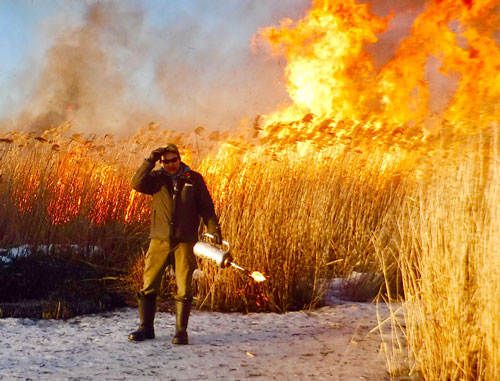What is Fire Reconciliation?
Reconciliation: Fire creates change.
kwēskipani-isīcikewin: iskotēw ōci kāmēskocipaniwin.Listen to Cree
In the spirit of reconciliation, fire creates change.
kwayaskosīcikewin ōci, iskotēw kika kāmēskocipaniw.Listen to Cree
There is a collective responsibility to position Indigenous-led fire practices as of equal value to settler and state-led fire management.
ininiwak-kanikanōtak iskotēw kākētwam itotamowina ōma māmawi kanākatēnicikatēk wīstawaw pēyakwan inikōk ka ki itakētēk tasko mistikōsiwak ēkwa iskotēw kapaminākik.Listen to Cree
-Solomon Carrière and Renée Carrière
(Muskrats to Moose Project Team Members; allies of change)
Reconciliation requires transformative change in attitudes, behaviours, relationships, structures and systems. Reconciliation can be accomplished through compassion, harmony, social justice and truth.
Reconciliation is a journey toward thoroughly changing something and then setting a new standard, for example, the uses of fire on the land.
In the 2021 Muskrats to Moose Project interviews, Solomon Carrière offers the following reflections on the term, “fire reconciliation”:

Solomon Carrière’s Reflections on Fire Reconciliation
It was noted, by all who were interviewed during the Muskrats to Moose Project, that a different lens is used to describe values at risk during a wildland fire, a term used now by the Government of Saskatchewan.
In the territory identified as the Saskatchewan River Delta, resource users include in their values at risk: land values, wildlife values, livelihood values, cultural values, spiritual values, emotional values and mental values.
Fire was and is understood by local people.
They understand when to use fire, how to use fire, where to use fire, the impacts of weather on fire, time of day to set fire. It was/is part of their cultural practices.
Indigenous Peoples and Indigenous scholars had and continue to have protocols, practices and research that supports the use of fire as a land management and cultural tool.
Differently, values at risk during a wildland fire, the term used by the Government of Saskatchewan, places value on different things like logging areas or larger infrastructure.
The Western understanding is that there needs to be a plan, on paper, that follows specific Western protocols and policies.
The braiding of fire practices between Indigenous and Western scientists should be to apply the local values at risk, ethics, skills and knowledge of Indigenous Peoples within specific lands, into a written form, for the extensive and continuous practice of fire on the land for revitalization.[1]
When safely used, Indigenous-led fire practices and prescribed burning are effective in fuel reduction, providing significant benefits to fire-dependent communities, ecosystems and wildlife.
While the Wildfire Act [section 26(2)(e)] does require a written plan, this law empowers the Crown (Government of Saskatchewan) to approve a resource management fire for the purpose of managing Crown land to maintain specific resource values. Therefore, the Act as currently written can incorporate the “local values at risk, ethics, skills and knowledge of Indigenous Peoples within specific lands” that Solomon Carrière advocates.
[1]Muskrats to Moose Project Team (2022). Muskrats to moose: Braiding cultural burning and Western fire management – interview – summary of findings. Turtle Island Consulting Services Inc., p. 14.
